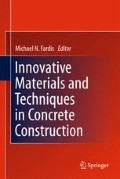Abstract
Test results of 20 Engineered Cementitious Composite (ECC) plates under 4-point bending are reported. 13 plates were pre-cracked to allow rotation of the principal stress directions, in order to permit the study of shear and tensile stress transfer at multiple cracks. Coarse aggregates were investigated as a possible means to improve shear-transfer. When subjected to principal stress rotation, ECC exhibited a nearly orthogonal crack pattern, indicating little contribution from the shear transfer mechanism. A reduction in flexural capacity was observed, depending on the relative angles of principal tensile stress applied. When coarse aggregate was added to ECC, significant reductions in flexural capacity and flexural ductility were observed. In a situation when principal stress direction rotated, however, the test results show that coarse aggregate in the amount of 15% of the maximum packing density of the aggregate used was effective to control the orientation of secondary cracks in cracked ECC and to maintain a comparable level of flexural capacity irrespective of the reorientation angle of principal stress field and the angle of pre-existing cracks.
Access this chapter
Tax calculation will be finalised at checkout
Purchases are for personal use only
References
JSCE (2007) Recommendations for design and construction of High Performance Fiber-Reinforced Cement Composite with multiple fine cracks (HPFRCC). Concrete Libr 127:129–135 (in Japanese)
Kunieda M, Rokugo K (2006) Recent progress on HPFRCC in Japan – required performance and applications. J Adv Concrete Technol 4(1):19–33
Li VC (2003) On Engineered Cementitious Composites (ECC). J Adva Concrete Technol 1(3):215–230
Li VC, Wu HC (1992) Conditions for pseudo strain-hardening in fiber reinforced brittle matrix composites. J Appl Mech Rev 45(8):390–398
Li VC, Wang S, Wu C (2001) Tensile strain-hardening behavior of PVA-ECC. ACI Mater J 98(6):483–492
Li VC, Lepech M, Li M (2005) Field demonstration of durable link slabs for jointless bridge decks based on strain-hardening cementitious composites. Michigan Department of Transportation Research Report no. RC-1471, p 110
Maekawa K (1983) Flow rule and plane stress constitutive equations of concrete. Concrete Eng 21(8):103–121 (in Japanese)
Naaman AE, Reinhardt HW (1996) Characterization of High Performance Fiber Reinforced Cement Composites – HPFRCC. High Performance Fiber Reinforced Cement Composites 2 (HPFRCC 2), In: Naaman AE, Reinhardt HW (eds) Proceedings of the second international RILEM workshop, E&FN Spon, London, pp 1–24
Suryanto B (2009) Mechanics of high-performance fiber-reinforced cementitious composite under principal stress rotation. PhD thesis, University of Tokyo, Japan
Suryanto B, Nagai K, Maekawa K (2010) Bidirectional multiple cracking tests on high-performance fiber-reinforced cementitious composite plates. ACI Mater J 107(5):450–460
Van Mier JGM (1985) Influence of damage orientation distribution on the multiaxial stress strain behavior of concrete. Cement Concrete Res 15:849–862
Author information
Authors and Affiliations
Corresponding author
Editor information
Editors and Affiliations
Rights and permissions
Copyright information
© 2012 Springer Science+Business Media B.V.
About this paper
Cite this paper
Suryanto, B., Nagai, K., Maekawa, K. (2012). Heterogeneous Fiber-Particle Composite Subjected to Principal Stress Rotation. In: Fardis, M. (eds) Innovative Materials and Techniques in Concrete Construction. Springer, Dordrecht. https://doi.org/10.1007/978-94-007-1997-2_11
Download citation
DOI: https://doi.org/10.1007/978-94-007-1997-2_11
Published:
Publisher Name: Springer, Dordrecht
Print ISBN: 978-94-007-1996-5
Online ISBN: 978-94-007-1997-2
eBook Packages: EngineeringEngineering (R0)

